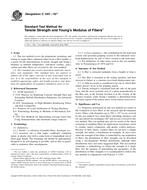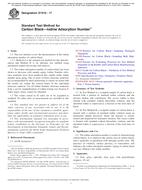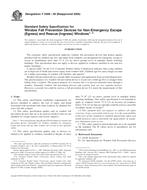1.1 It is the intent of this guide to set forth criteria and procedures for the design, fabrication and installation of nuclear fuel dissolution facilities. This guide applies to and encompasses all processing steps or operations beyond the fuel shearing operation (not covered), up to and including the dissolving accountability vessel.
1.2 Applicability and Exclusions:
1.2.1 Operations – This guide does not cover the operation of nuclear fuel dissolution facilities. Some operating considerations are noted to the extent that these impact upon or influence design.
1.2.1.1 Dissolution Procedures – Fuel compositions, fuel element geometry, and fuel manufacturing methods are subject to continuous change in response to the demands of new reactor designs and requirements. These changes preclude the inclusion of design considerations for dissolvers suitable for the processing of all possible fuel types. This guide will only address equipment associated with dissolution cycles for those fuels that have been used most extensively in reactors as of the time of issue (or revision) of this guide. (See Appendix X1.)
1.2.2 Processes – This guide covers the design, fabrication and installation of nuclear fuel dissolution facilities for fuels of the type currently used in Pressurized Water Reactors (PWR). Boiling Water Reactors (BWR), Pressurized Heavy Water Reactors (PHWR) and Heavy Water Reactors (HWR) and the fuel dissolution processing technologies discussed herein. However, much of the information and criteria presented may be applicable to the equipment for other dissolution processes such as for enriched uranium-aluminum fuels from typical research reactors, as well as for dissolution processes for some thorium and plutonium-containing fuels and others. The guide does not address equipment design for the dissolution of high burn-up or mixed oxide fuels.
1.2.2.1 This guide does not address special dissolution processes that may require substantially different equipment or pose different hazards than those associated with the fuel types noted above. Examples of precluded cases are electrolytic dissolution and sodium-bonded fuels processing. The guide does not address the design and fabrication of continuous dissolvers.
1.2.3 Ancillary or auxiliary facilities (for example, steam, cooling water, electrical services) are not covered. Cold chemical feed considerations are addressed briefly.
1.2.4 Dissolution Pretreatment – Fuel pretreatment steps incidental to the preparation of spent fuel assemblies for dissolution reprocessing are not covered by this guide. This exclusion applies to thermal treatment steps such as “Voloxidation“ to drive off gases prior to dissolution, to mechanical decladding operations or process steps associated with fuel elements disassembly and removal of end fittings, to chopping and shearing operations, and to any other pretreatment operations judged essential to an efficient nuclear fuels dissolution step.
1.2.5 Fundamentals – This guide does not address specific chemical, physical or mechanical technology, fluid mechanics, stress analysis or other engineering fundamentals that are also applied in the creation of a safe design for nuclear fuel dissolution facilities.
1.3 The values stated in inch-pound units are to be regarded as standard. The values given in parentheses are mathematical conversions to SI units that are provided for information only and are not considered standard.
1.4 This standard does not purport to address all of the safety concerns, if any, associated with its use. It is the responsibility of the user of this standard to establish appropriate safety and health practices and determine the applicability of regulatory limitations prior to use.
Product Details
- Published:
- 06/01/2008
- Number of Pages:
- 17
- File Size:
- 1 file , 140 KB


